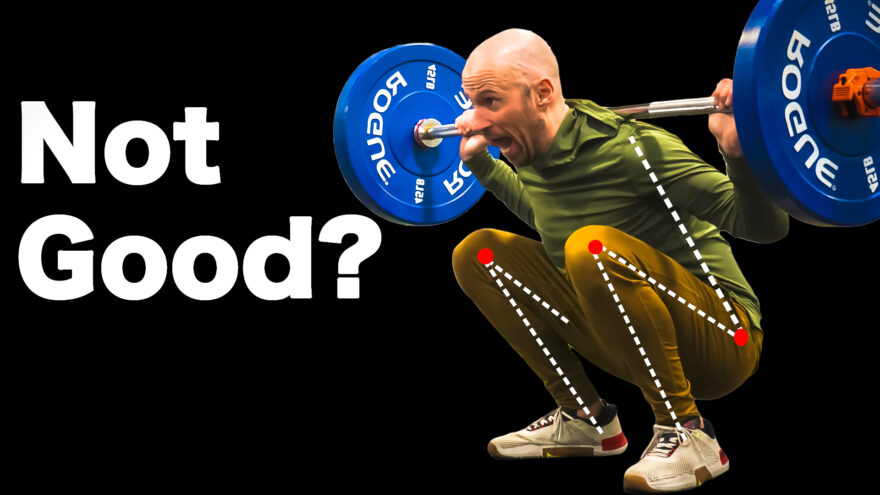Table of Contents
The worst way to squat
Are you confused about how to squat properly? You may have heard that squatting below parallel with your knees over your toes is harmful.
But is this really true?
In this blog post, we’ll explore the science behind squatting. You’ll learn how to improve your squats to make them more effective and comfortable.
Read on, watch the video, and listen to the podcast to learn about it!
Is deep squatting bad?
It is true that squatting deep and pushing your knees over your toes stresses the knees, but how much?
Not as much as you’d think.
In fact, this study shows that a back squat places 11 N/kg of pressure on the knee. A front squat does about 9 N/kg.
Compare that to a 1.5-time bodyweight deadlift. The spinal compressive loads range from 3000-7500 N!
Moreover, the most compressive load in the knee joint occurs at 90º-100º to 100 degrees of knee flexion. Also known as squatting to parallel.
Once you break parallel, knee loading decreases for a few reasons.
When you flex the knee, your calf and hamstring muscles contact each other. This gaps the knee joint. Additionally, the quad tendon contacts the intercondylar notch, creating a knee wrap effect. Both of these factors reduce knee stress when squatting below parallel.
So everyone should squat deep?
Although deep squats are safe, we may have limited mobility that prevents this.
Deep squats need:
- Adequate hip flexion and rotation
- Ankle dorsiflexion
- Knee flexion
Have limited mobility? You can squat progressively lower by working on the following areas:
- Posterior lower pelvis
- Posterior upper pelvis
Let’s dive into how to improve each.
Posterior lower expansion
The posterior lower pelvis is the distal part of the glutes. This area must become eccentric.
For that, hinging moves work best. A reaching box squat is my favorite.
Performance keys
- Unlock your knees
- Silent nasal inhale
- Exhale through the mouth
- While exhaling, reach the plate forward to get the hips back without locking your knees out.
- Inhale and sit down onto the box without rocking back.
- Exhale and stand up.
- Drill this move for three to four rounds of six to eight reps when you’re first learning how to squat.
- Eventually, transition to the warmup where you’ll do about two rounds of eight to ten reps.
Once this gets easy, you can switch to a loaded box squat variation:
I’ll perform 3-4 sets x 6-12 reps for this.
Posterior upper expansion
Once box squatting has gotten easy, you’ll want to progress to ramp squat variations. The ramp helps you get deeper by encouraging a posterior weight shift.
I like to start by nailing a goblet squat.
I’ll work through the exact same sets and reps per above. Progressing to loaded variations.
From the goblet squat, I’ll go to a sandbag squat:
Then a zercher squat:
Then finally, a front squat:
Sum up
While squatting deep can stress the knees, the amount of pressure is not that significant.
With proper form and adequate mobility, you can squat all the way down. This will enhance your mobility and work your legs harder. Use the progression outlined above to prep yourself for squatting and avoid injury.
What squats do you perform? Comment below and let us know
